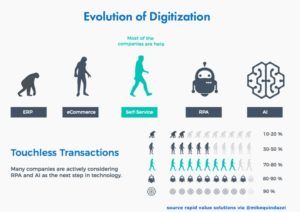Change typically isn’t a very popular concept– especially when it’s happening in the workplace. Unfortunately for resistant employees, though, change is necessary for progression and growth, especially in today’s ever-changing technological landscape. In the evolution of digitization, most companies are currently at the “self-service” phase, meaning that most companies’ digitization has advanced past ERP and eCommerce. The next phase? Robotic process automation (RPA).
 Unlike biological evolution, the progression of digitization and technology is rapid. Deloitte reported that 53% of 400 companies have already embarked on their RPA journey.
Unlike biological evolution, the progression of digitization and technology is rapid. Deloitte reported that 53% of 400 companies have already embarked on their RPA journey.
Many corporations are hesitant to make the jump towards implementing RPA because they’re afraid of the shock it will have on employees. In fact, that’s proven to be true with any cutting-edge technology that will impact an employee’s role, even if it will make their job easier. Implementing RPA isn’t just a quick addition to your employees’ toolkits, either. Its implications will change the way teams within the company are structured, eliminate roles and create new opportunities. It’s a very disruptive… and very worthwhile. You can reposition skilled employees to more rewarding and higher revenue-generating work and utilize their human talents more such as creativity, critical thinking, imagination and communication– all things that RPA bots don’t possess.
Although the benefits of RPA are abounding, any major change in technology that will alter your employees’ daily activities will require efficient preparation and change management. They’ll be feeling the disruption, and you’re going to have to make a good case for RPA just to keep your employees optimistic. Here are some tips to get your team geared up for the inevitable technological evolution.
Make sure they know RPA is a tool that will help them, not replace them. Frame it as an opportunity.
RPA remains a fear for many in the workforce because it’s perceived as a threat that will eventually replace humans. Yes, there are instances where this has been the case, but for the most part RPA has the potential to provide more professional opportunities to your employees.
Since RPA’s main objective is to take over the burden of monotonous human computer tasks like collecting, synthesizing and organizing data, it frees up more time for employees to focus on interesting and creative aspects of their role. Not only will your employees be able to invest more of their time in analyzing data and strategizing for larger business initiatives, but RPA implementation could result in more jobs, not less. Deloitte highlights a classic example of a feared technology that created more jobs once it was implemented: the ATM.
“Prior to implementation, there was outcry over potential job losses as machines would be replacing bank workers. The outcome, however, was the opposite: hiring actually increased in the average banking organization. In essence, RPA empowers people to increase their individual value, connect more fully with the purpose and strategy of their organizations, and to reach markets that limitations on capacity and mobility had previously kept out of reach.”
This isn’t even considering the roles that will need to be put in place to manage the RPA solution itself, such as a controller to manage scheduling and monitor processes and a process developer to maintain model processes if applications change, in addition to others.
Maintain communication and transparency with your team before, during and after RPA implementation.
Communication in this case includes involving your team in the implementation strategy and making sure they understand the specific goals of the solution. Explain the big picture with specific detail; make sure they understand how the RPA solution will contribute to the overall business strategy instead of just throwing a new, unknown technology at them. Highlight how it will alter their daily activities. Even better than this, engage your team in assessing which processes should be candidates for automation. If they have a stake in the implementation from the very beginning, not only will they have a better understanding of the technology, but they’ll naturally be less resistant. Your employees know the ins and outs of the current process, so rely on their expertise. They may be aware of bottlenecks and other process issues that RPA could solve. After implementation, continue to encourage them to offer suggestions for the solution as well as to think outside the box as to how to better utilize their human abilities.
Train employees in advance.
Build up your employees’ confidence in RPA before any official implementation by training them in advance. RPA is not extremely intensive to implement and doesn’t require a lot of IT involvement, so your non-IT employees can learn to use templates to configure and even deploy robots. Make sure you include both technical training as well as leadership training. This combination of technical knowledge and human skills like communication, critical thinking and problem-solving will help sustain the hit to your employees’ daily routine and give them more insight to the technology.
Start small.
A great way to let hesitant employees test the RPA waters before full implementation is to identify a single pain point in your team’s process and test your RPA solution that way. Employees will be much more receptive to the new technology (and quite possibly their new role) if they have a chance to feel it out and offer feedback before their processes become automated. Pick a process that has a high volume of data for which a rules-based process can be applied for an easy, secure start. Your team will be able to get the idea with little to no issues along the way.
The greatest challenge in RPA isn’t really in the implementation itself, but rather in the disruption it will cause in the way the business operates. According to Deloitte, as many as 70 percent of process transformations or technology implementations “fail due to poor change management.” Use these tips to develop a solid strategy that will keep your employees optimistic about RPA rather than fearful or resistant.
To learn more about RPA implementation, click the image below to watch our free on-demand webinar.


